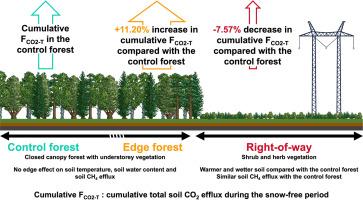Soil CO2 and CH4 effluxes in powerline rights-of-way and their adjacent forests
IF 5.7
1区 农林科学
Q1 AGRONOMY
引用次数: 0
Abstract
Global decarbonization will require a large deployment of power grids to convey electricity. The right-of-way (i.e., the cleared area below the pylons, where vegetation is periodically maintained) is a land-use change that involves changes in soil and vegetation and their carbon dynamics both within the rights-of-way and in adjacent forests, notably via an edge effect. Our main objective was to assess whether soil CO2 effluxes (FCO2), soil CH4 effluxes and microclimate (soil temperature and water content) differed between powerline rights-of-way and their adjacent forests compared to control forests over a large bioclimatic gradient of upland sites across the temperate and boreal forests of Eastern Canada. Monthly efflux measurements were carried out between May and October 2023 and 2024 in eight rights-of-way and their adjacent edge and control forests. Overall, cumulative total FCO2 during the snow-free period were lower (–7.57 %) in rights-of-way and higher (+11.20 %) in the edge forests compared to the control forests. However, these results were not consistent across the bioclimatic gradient: balsam fir forests, contrarily to forests from both cooler and warmer bioclimatic domains, showed enhanced soil respiration in rights-of-way. Overall, soils were warmer and wetter in rights-of-way compared to control and edge forests; however, no effects were found on the soil methane uptake. Our study indicated that the presence of a powerline right-of-way influences soil biogenic carbon emissions. Effects are related both to changes in abiotic and biotic conditions. These estimates should improve the assessment of the carbon footprint of power transmission and electricity deployment.

电力线路权及其邻近森林的土壤CO2和CH4外排
全球脱碳将需要大规模部署电网来输送电力。路权(即,定期维护植被的塔下清理区域)是一种土地利用变化,涉及路权范围内和邻近森林的土壤和植被及其碳动态的变化,特别是通过边缘效应。我们的主要目标是评估在加拿大东部温带和北方森林的大生物气候梯度上,与控制森林相比,电力线路权及其邻近森林之间的土壤CO2通量(FCO2)、土壤CH4通量和小气候(土壤温度和含水量)是否存在差异。在2023年和2024年5月至10月期间,对8个路权及其邻近边缘和控制林进行了每月外排测量。总体而言,与对照林相比,无雪期路权区累积总FCO2较低(- 7.57%),边缘林较高(+ 11.20%)。然而,这些结果在整个生物气候梯度上并不一致:与来自较冷和较暖生物气候域的森林相反,香脂冷杉林在路权上表现出增强的土壤呼吸。总体而言,与对照森林和边缘森林相比,路权地区的土壤更温暖、更湿润;然而,对土壤甲烷吸收没有影响。我们的研究表明,电力线路权的存在会影响土壤生物碳排放。影响与非生物和生物条件的变化有关。这些估计将改善对电力传输和电力部署的碳足迹的评估。
本文章由计算机程序翻译,如有差异,请以英文原文为准。
求助全文
约1分钟内获得全文
求助全文
来源期刊
CiteScore
10.30
自引率
9.70%
发文量
415
审稿时长
69 days
期刊介绍:
Agricultural and Forest Meteorology is an international journal for the publication of original articles and reviews on the inter-relationship between meteorology, agriculture, forestry, and natural ecosystems. Emphasis is on basic and applied scientific research relevant to practical problems in the field of plant and soil sciences, ecology and biogeochemistry as affected by weather as well as climate variability and change. Theoretical models should be tested against experimental data. Articles must appeal to an international audience. Special issues devoted to single topics are also published.
Typical topics include canopy micrometeorology (e.g. canopy radiation transfer, turbulence near the ground, evapotranspiration, energy balance, fluxes of trace gases), micrometeorological instrumentation (e.g., sensors for trace gases, flux measurement instruments, radiation measurement techniques), aerobiology (e.g. the dispersion of pollen, spores, insects and pesticides), biometeorology (e.g. the effect of weather and climate on plant distribution, crop yield, water-use efficiency, and plant phenology), forest-fire/weather interactions, and feedbacks from vegetation to weather and the climate system.

 求助内容:
求助内容: 应助结果提醒方式:
应助结果提醒方式:


